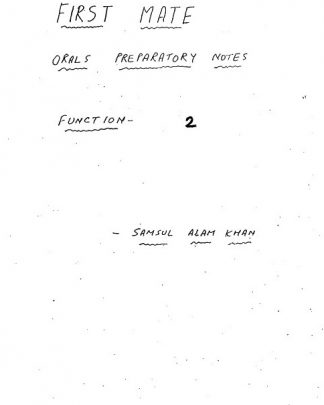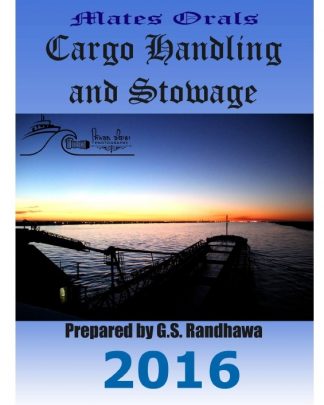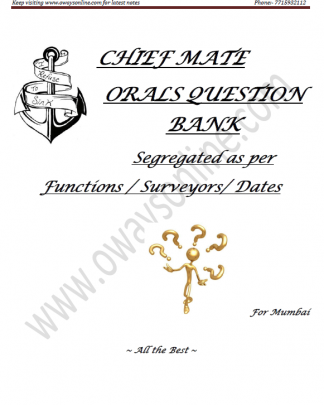Capt. Uppal Function 2 Chief Mate Orals F.G. Exams Question Set Mumbai.
DATE | SURVEYORS | QUESTIONS | FUNCTION |
| 4-JUNE-18 | UPPAL | Bulk carriers not sailed but must know – how u carry out draught survey. Difference between PV valves and pv breakers – they work for same cause but why different construction. Tanks fully loaded u just signed on Master asks calc the cargo . Principal of UTI Requirements for loading grain . Compactibility n segregation as per Category 1 . | F2 |
| 18-JUNE-18 | UPPAL | -why draft survey of ballast vl – use of constant – draft survey calculation – why trim correction – what is fwd perpendicular – what is frst trim correction – Bill of lading – what will shipper do with it – why PV valve is not ig line -how will u load class 1 good – compatiblty and segregation for class 1 – subclass of class 1 – grain stability requirements – full grain stability calculation and explain me with diagram, why it’s like that – what is void in grain ship – what is chain register – why annealing is Carried out | F2 |
| 11-OCT-18 | UPPAL | Last failing questions Concentrates hazards How can you rely on certificate given by shipper for tml. I said many points but what he wanted to hear is that the laboratory which gives this cert is it approved by administration. You are joining as a mate on a loaded tanker to take over. Calculate the cargo loaded. Gave him all the steps of calculation but he figured out that i have never used api tables in actual. VGM, flammability diagram in detail, what is purging, inerting….. | F2 |
| 11-MAR-19 | UPPAL | How many vols are there in imdg . What all is included in the supplement How will you use mfag What is imdg class 1 and it’s relationship to segregation and compatible tables. Types of gas carriers. – he wanted to her the survival capability. And asked to explain. Isgott and what are its contents. Not word to word. Just a brief understanding | F2 |
| 8-APRIL-19 | UPPAL | -Draft survey explanation, all steps of calc -bill of lading, who signs it nd issues it, when not to sign BL -what is HVVV -PV valve -PV breaker -diff between pv valve nd pv breaker, why two system given -asked hv I done dry dock, I said yes during cadetship, so aksed what is shear strake, deck plate joining shear strake, what is that plate called. What is purging, why is it done when hold is already in inert condition -little bit of cross Q, not much. | F2 |
| 6-MAY-19 | UPPAL | Tank cleaning and tank entry procedure for oil Tankers, purging and gas freeing methods Content of Imdg and IMSBC DOA in detail, stability requirement for grain Method for checking the mc of concentrate on board, precautions for loading concentrate Imdg supplements in detail Flammable diagram understanding Hvvv’s and why vent speed is 30m/s | F2 |
| 13-MAY-19 | UPPAL | – Imdg volumes – Imdg segregation – load class 1 with class 1 cargo – what is magazine? – Types of magazines – pv breaker and pv valve difference – why pv breaker is not in all tanks and what if we will put PV valve of same pressure instead of pv breaker – Purging and inerting, why we purge which is still in inert condition – TLV – why initial draft survey is carried out – Draft survey – why 1st trim and 2nd correction? – Is any segregation in imsbc – Coal loading in detail – Principle of css Code – how to go about cargo which are not in imsbc | F2 |
| 3-JUNE-19 | UPPAL | 1. Loading of Coal. Hazard, precautions. 2. What is concentrate? Loading of concentrate. 3. What is TLV? 4. Draft survey in full detail. ( Lot of cross questioning) 5. IMDG contents 6. How will you segregate Class 1 (Also list the sub classes of class 1) 7. Contents of IMDG Supplement. | F2 |
| 17-JUNE-19 | UPPAL | 1. Chain register. Who issues it? 2. Loading of iron ore in monsoon in India. Which circular what it mentions? 3. Hazards of ores 4. IMSBC code | F2 |
| 17-JUNE-19 | UPPAL | 1. Purging (Wants to hear gas freeing of tank in inerted condition) 2. What is TLV,TWA, STEL and ceiling limit. 3. Timber code contents and lumber load line. Is there any difference between lumber summer draft and normal summer draft & y? 4. On a bulk carrier Initial Draft survey in full detail. Why 1st trim correction 5. IMDG contents and Supplements 6. What is Ems 7. Segregation as per Imdg. 8. Chain register 9. HVV? Why 30m/sec 10. Bill of lading? Who issues it? | F2 |
| 9-SEPT-19 | UPPAL | Tanker calculation in detail. Draft survey calculation and why we do. Static and dynamic test. Iron ore and concentrate loading, including precaution and hazards. Chain register. He is much in IMDG explosive. Classes of IMDG Subcategory of explosive Segregation of explosive( not away from, seperated from) Principle of UTI What is compatibility and segregation of class 1 IMDG | F2 |
| 13-MARCH-20 | UPPAL | 1. Why are there different arrangements for PV Valve and PV Breaker it they are there for the same purpose? 2. What is the compatibility table and what is the segregation table for class 1 Cargo? 3. How will you go about a draft survey on a bulk carrier? Why do we add or subtract the first and second trim correction? What is the purpose? 4. How will you perform a flow test? What is TML? | F2 |
| 3-AUG-21 | UPPAL | -Imgd code how many volume explain each volume and chapter.(he wanted to know how many pages for volume 2 dangerous goods list and how many columns what information is written in columns) -ISGOT what it contains. -Imsbc contents , concentrate hazards and loading procedure – coal hazards loading procedure -As choff what factors to consider on bulk carriers. – grain stability requirement. – flammability diagram explain, what is purging why it is done, what is critical dilution line. -Mate’s receipt -What is bill of lading who issues it. -Dg manifest. Some more I don’t recollect | F2 |
| 4-AUG-21 | UPPAL | Imgd code salient feature and chapter quote, Many Cross questions on imdg on basis of both volumes chapter wise, Imsbc contents , concentrate hazards and loading procedure, As choff what factors to consider on bulk carriers, Chemical taker types and define, Chemical tanker Construction parameters, Ig gas and proportion of all gases, Type of deck seals and explain wet type, Mate’s receipt, Bill of lading who issues it, Dg manifest and explain, Imdg code what all colums in list of dg, Some more I don’t recollect | F2 |


